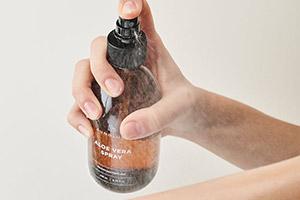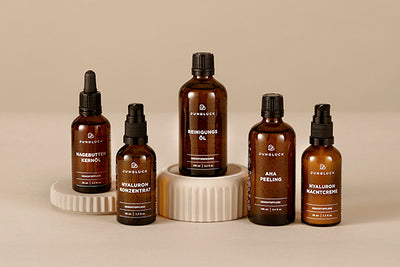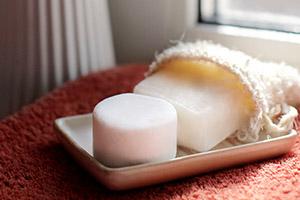Curly, straight, fine, frizzy, colored or wild - we love diversity! We collected valuable insights for healthy hair so that you exactly know which treatment is best for your hair.
- Hair care - the structure of the hair
- Hair care - Tip 1: wash your hair properly
- Hair care - Tip 2: use conditioner for healthy hair
- Hair care - Tip 3: avoid heat
- Hair care - Tip 4: suitable hair care products for healthy hair
- Hair care - Tip 5: use high quality hair care tools
Sometimes, our hair is just like our skin. What it really needs depends above all on the type of hair. However, there are certain things that hair and scalp in general don't like and things that your hair will thank you for with a healthy shine - at least if done regularly. Of course, there will always be the occasional bad hair day, but with the right haircare, the good hair days will outweigh the bad. But before we look at the hair care 101, let's take a look at the structure of hair.

1. Hair care - the structure of the hair
Hair consists of a hair shaft and a root. The visible part is the hair shaft, which we call our hair. Each hair consists of three layers: Cuticle, Cortex and Medulla.
The outermost layer, called the cuticle, consists of dead cells. Healthy hair with an intact cuticle is shining in the light because the horny plates are lying flat, similar to a pine cone. When light falls on the hair, it reflects the cuticles and the hair shines. If the cuticle is roughened, the hair looks dull, tangles quickly, and split ends are often visible at the tips of the hair.
The largest part of the hair is made up of the second layer, the fiber layer (cortex). It consists of fine keratin fibers. A kind of putty substance connects the fibers and makes them elastic and tear-resistant. This layer plays a decisive role in chemical treatments such as bleaching or perming. Inside is the medulla, also called the medullary canal. For hair care, this layer plays no role.
Good hair care is worth the effort, because once the cuticle is damaged, anti-spliss products can only repair the protruding horny platelets until the next hair wash. Sadly, the only thing that helps with split ends is a haircut. With our hair care tips for healthy hair, you can easily prevent dryness and split ends.
2. Hair care - Tip 1: wash your hair properly
Many people consider washing their hair to be part of their daily care routine. But how often should you wash your hair? It is enough to wash your hair every two to three days - especially if your scalp and hair are very dry. If your roots become greasy very quickly, you can also wash your hair daily with a mild shampoo.
However, the sebum from the sebaceous gland in the scalp has an important function. It covers the skin like a delicate protective film and thus prevents the penetration of germs and harmful substances. It also keeps the scalp and hair smooth. Washing your hair frequently with shampoos containing highly degreasing surfactants or other potentially irritating ingredients such as fragrances or chemical preservatives can disrupt the delicate protective film and lead to an imbalance of the scalp.
A mild hair care product like our unscented shampoo gently cleanses hair and scalp with mild sugar surfactants. At the same time, it provides hair and scalp with a real moisture boost thanks to over 40 percent organic aloe vera juice. Our solid shampoo bar contains gentle coconut surfactants, nourishing plant oils and aloe vera to nourish and soothe the scalp and hair. Both shampoos are so mild and well tolerated that they can be used every day without irritating the scalp.
This is how you properly apply the shampoo:
Spread the shampoo in the palms of your hands and apply.
Gently massage the shampoo into the scalp in circular motions. The light massage cleanses the hairline and scalp. At the same time, the microcirculation in the scalp is stimulated. In this way, the cells receive a better supply of nutrients and oxygen.
Always try to massage in the direction of hair growth to avoid unnecessary roughening of the cuticle.
Normally, it is sufficient to shampoo only the scalp. Lengths and tips are sufficiently cleaned when rinsing. Except if you have previously dabbled in mud, visited the Holi Festival or left an oil treatment to work overnight, then the lengths and tips should also be shampooed.
Avoid too hot water, it removes grease from the skin and causes the hair to swell. Even if it takes some effort, lukewarm water is kinder to your hair and skin. Nice side effect: Your utility bills and the environment also benefit from lower energy consumption.

OUR (SOLID) SHAMPOO BAR
Cleanses and cares for the scalp and hair with plant surfactants and natural aloe vera.
3. Hair care – Tip 2: use conditioner for healthy hair
For extra gloss and suppleness, finish off with a conditioner. The slightly acidic pH of this hair care product closes the cuticle. Nourishing active ingredients such as organic coconut oil and organic shea butter in our solid and environmentally friendly conditioner bar nourish the hair and make it silky and soft. It also contains a plant-based wax that protects the hair all the way to the ends, making it less prone to split ends and dryness.
If your scalp is dry and your hair is thick or curly, you can also apply the conditioner directly to the roots. For fine hair, apply only to the lengths and ends and rinse with lukewarm water.
Colored or bleached hair is particularly sensitive because the chemical treatment has loosened the cuticle. For this reason, chemically treated hair should always be treated with a conditioner after washing. On top of that, it should be regularly nourished with a hair mask. By the way, you can easily prepare this yourself at home.
Vegan DIY hair mask:
- Pour some organic almond oil into a bowl (less if you have fine hair)
- Mash an organic banana
- Add a little organic coconut milk
Mix the ingredients and apply to towel-dried hair. If the scalp is very dry and itchy, the DIY hair mask can also be applied to the hairline and massaged in. Leave on for about 20 minutes, preferably under a shower cap or a towel turban, as the hair will absorb the hair mask even better due to the resulting heat. Rinse thoroughly and voilà!
4. Hair care - Tip 3: avoid heat
Whether it's a blow dryer, straightener, curling iron or hot water, hair and scalp don't like heat. If possible, let your hair dry in the air. If you can't do without a blow dryer or other styling tools, avoid using the hottest setting and be careful not to expose your hair to heat for too long. Always hold the blow dryer in the direction of the hair's growth so that the cuticle does not stand up, and keep the air moving a little.

5. Hair care - Tip 4: suitable hair care products for healthy hair
Just like skincare, hair care should be tailored to individual needs. Is it possible to take too much care of your hair? Yes! In fact, you can weigh it down with hair care products that are too rich. Here is a brief overview of hair and scalp conditions and suitable hair care products.
Haircare for dry and itchy scalps
Use mild shampoo with nourishing oils, such as our solid shampoo.
Wash hair with lukewarm water.
After washing your hair, gently pat dry, do not rub.
If possible, let the hair dry in the air.
Aloe vera gel or spray soothes irritated scalp and hydrates it.
Rose water helps the scalp to regain its balance and moisturizes. Also suitable for fine hair.
Apply a little almond oil or argan oil to dry areas in the evening and leave on overnight. If necessary, massage the entire scalp in the evening with a plant-based care oil.
Hair care for oily scalp
Use light hair care products like our transparent shampoo.
Always apply conditioner to lengths and ends only.
Rose water can balance the activity level of the sebaceous glands - spray on the scalp after washing the hair.
Between washes, a dry shampoo freshens up the hairstyle.
Haircare for dry tips
Always use a conditioner.
For fine hair, apply rose water or aloe vera spray to lengths and ends.
For strong hair, curls or frizzy hair, rub a little almond oil or our fine argan oil from controlled organic cultivation into the palms of the hands and massage into the ends.
After washing, blow-dry hair only gently at the roots, then leave to air-dry.
Protect your hair from UV radiation, chlorine and salt water. Apply a little almond oil or argan oil to the ends before going to the beach or pool.
Hair care for curls
Curls love nourishing oils and moisture. After washing your hair knead a little argan or almond oil into the length.
Treat fine hair with waves or curls with a light moisturizer, such as aloe vera spray.
Never brush curls, it is best to comb them with your fingers.
Use shampoo only when necessary - for very dry hair, water and conditioner between two hair washes is sufficient.
Hair care for fine hair
Fine hair quickly becomes stringy and is particularly sensitive to mechanical stimuli and environmental influences. To keep them falling in a fresh and fluffy way, they need a treatment that does not weigh them down and provides them with plenty of moisture.
Use mild, clear shampoo. For very fine hair, apply just a touch of conditioner to the tips.
As an alternative to conditioner or if needed, spray on a little aloe vera spray.
Dry shampoo or hair powder gives the hair more grip and volume and prevents rapid greasing.
Brush carefully from the tips to the roots to avoid hair breakage.
Hair care for split ends and hair breakage
Split ends can only be temporarily repaired with anti-split care; the split ends are visible again with the next wash. Therefore, it is worth preventing hair breakage with intensive treatment for healthy hair.
If the cuticle is severely damaged, split ends will develop. To prevent the hair from splitting further, have the tips cut regularly.
Never rub your hair dry, only gently pat it dry.
If you let your hair grow straight, the tips often hit your shoulders and break. Use a soft hair tie to twirl your hair into a loose bun to protect the ends during the transition phase.
Regularly nourish the ends with a little oil to keep them smooth.
Hair care for dandruff
There is dry and greasy dandruff. While oily dandruff or a very irritated scalp should be examined by a dermatologist, dry dandruff is often caused by incorrect hair care products or certain care habits. However, dandruff can also increase during hormonal fluctuations or stressful phases. Relaxation exercises or time out in nature can help you find your balance more quickly. You can also easily optimize your beauty routine:
Use a mild shampoo or, if necessary, special hair care products for dandruff.
Haare mit lauwarmem Wasser waschen.
Treat the scalp with our soothing and moisturizing aloe vera gel or the extra light aloe vera spray.
Ensure a healthy and balanced diet with high-quality omega-3 fatty acids (for example linseed oil).

6. Hair care – Tip 5: use high-quality hair care tools
Mechanical irritants such as sharp-edged hairbrushes or combs can tear the cuticle. Use only high-quality products with rounded nubs, preferably made of sustainable materials to protect the environment.
A microfibre towel absorbs moisture quickly because the material is very absorbent. However, those who pursue a sustainable lifestyle might be bothered by the less environmentally friendly material such as polyester or nylon from which the towels are made. When these synthetic materials are washed, the finest fibers dissolve and end up in the waste water, from where they usually end up as microplastics in the water. Even the most modern filter systems cannot hold them back. A skin-friendly towel made of fine organic cotton is equally suitable and is a more sustainable solution.
Bottom line – healthy hair
Very few people have the beautiful, healthy hair you see in commercials. With our hair care tips for healthy hair, you can support your hair wonderfully and grow your personal dream hair - without any chemical ingredients that irritate your skin or pollute the environment.
Regularly cutting the tips should be done whenever needed - for most women with longer hair, the tips should be cut about every six to eight weeks. With a balanced diet and a healthy lifestyle, you are taking care of your hair from the inside, because just like the skin, the condition of the hair and scalp is closely related to your personal lifestyle. Taking supplements such as biotin or silicic acid can also have a positive effect. I wish you lots of fun and success with this hair care update for healthy hair!





Leave a comment